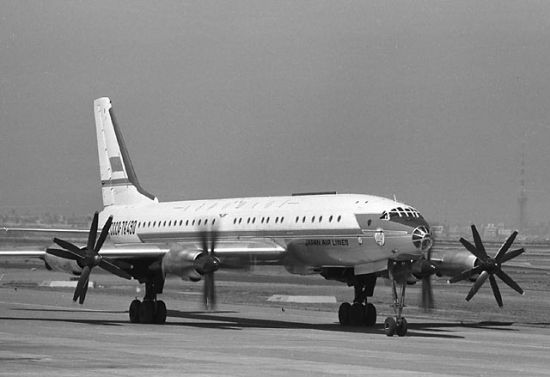|
||||||||||
|
|
||||||||||
|
||||||||||
|
|
||||||||||
 - -
|
|

|
Tupolev Tu-114 Rossiya ASCC codename: Cleat Long-Range Jetliner |
|
DESCRIPTION:
Just as Tupolev had successfully adapted the Tu-16 bomber into the Tupolev Tu-104 medium-range airliner, the design bureau was instructed to develop an airliner with intercontinental range based on the Tu-95. The resulting Tu-114, like its military cousin, came as a great surprise to western observers shocked that a propeller-driven aircraft could operate at jet-like speeds. The key to the success of the Tu-95/Tu-114 family was the development of the enormous and powerful NK-12 turboprop designed by the Kuznetsov Design Bureau, although most of the work was done by a team of captured German scientists. Still the most powerful turboprop engine ever built, the NK-12 converted its shaft power into thrust through gigantic four-bladed counter-rotating propellers mounted in pairs on each engine. While the Tu-114 was still being designed, the bureau decided to quickly convert three demilitarized Tu-95 airframes into the Tu-116. The purpose of the Tu-116 aircraft was to conduct route and scheduling studies, propulsion system tests, and study compatibility issues with civil airports. Common to the Tu-95, Tu-116, and Tu-114 were the four engines, enormous swept wing, and long landing gear units necessitated by the large-diameter propellers. While the Tu-116 prototypes utilized essentially the same fuselage as the Tu-95, the Tu-114 incorporated a completely new fuselage of increased diameter. This widened fuselage permitted greater internal volume for passengers. In addition, the wing was mounted lower on the fuselage to improve the cabin floor layout. The flight crew was seated in a forward fuselage reminsicent of that on the Tu-95 bomber, including a glazed window encasing the navigator's position in the nose. The main cabin was huge by 1950's standards with accomodation for 120 to 220 passengers. The cabin was divided into several different sections. First of these was a forward cabin seating 42 passengers, followed by a section of large coat closets. Next came a dining compartment with tables and seating for 48 and a galley compartment with elevators to bring food up from the kitchen on the lower deck. Further aft was a small compartment seating two of the five cabin crew and two small compartments providing additional seating or sleeping berths. Finally came the main cabin with accomodation for 54 passengers seated three abreast plus a compartment of washrooms and additional coat closets. After setting a number of records, including a speed record for fastest turboprop-powered aircraft that still stands today, the first of 31 examples of the Tu-114 entered service with Aeroflot. The enorous plane was used on long-range domestic and international routes. Among the cities served by the Tu-114 were Delhi, Havana, Montreal, Paris, and Copenhagen. Additional flights were made to Tokyo operated jointly with Japan Air Lines and flown by mixed Soviet-Japanese crews. The Tu-114 began to be replaced by the Il-62 in 1971 and was withdrawn from civil service in 1975. Several were given a new lease on life after being converted into Tu-126 airborne early warning platforms.
Last modified 17 March 2011
|
|
| HISTORY: | |
| First Flight |
(Tu-116) late 1956 (Tu-114) 3 October 1957 |
|
Service Entry
|
24 April 1961
|
| CREW: |
five flight crew: pilot, co-pilot, navigator, radio operator, flight engineer five cabin crew: three flight attendants, two cooks |
| PASSENGERS: |
120 long-range nonstop flights 170 normal operations 220 high-density |
|
ESTIMATED COST:
|
unknown
|
| AIRFOIL SECTIONS: | |
| Wing Root | TsAGI SR-5S |
|
Wing Tip
|
TsAGI SR-5S
|
| DIMENSIONS: | |
| Length | 177.33 ft (54.10 m) |
| Wingspan | 167.50 ft (51.10 m) |
| Height | 50.67 ft (15.50 m) |
| Wing Area | 3,348.76 ft² (311.10 m²) |
|
Canard Area
|
not applicable
|
| WEIGHTS: | |
| Empty | 200,620 lb (91,000 kg) |
| Normal Takeoff | unknown |
| Max Takeoff | 376,990 lb (171,000 kg) |
| Fuel Capacity |
internal: 18,920 gal (71,615 L) external: not applicable |
|
Max Payload
|
66,140 lb (30,000 kg)
|
| PROPULSION: | |
| Powerplant | four Kuznetsov NK-12MV turborpops each driving two AV-60H counter-rotating four-balded reverse-pitch propellers |
| Thrust |
59,180 eshp (44,132 ekW)
|
| PERFORMANCE: | |
| Max Level Speed |
at altitude: 540 mph (870 km/h) at 26,250 ft (8,000 m), Mach 0.78 at sea level: unknown cruise speed: 480 mph (770 km/h) at 29,500 ft (9,000 m), Mach 0.70 |
| Initial Climb Rate | unknown |
| Service Ceiling | 39,370 ft (12,000 m) |
| Range |
4,830 nm (8,950 km) with 33,070 lb (15,000 kg) payload 3,345 nm (6,200 km) with 66,140 lb (30,000 kg) payload |
| Endurance | unknown |
| g-Limits |
unknown
|
| KNOWN VARIANTS: | |
| Tu-116 | Demilitarized Tu-95 bomber used as a prototype with the weapons bay and tail turret deleted and a 24 or 30 seat four-abreast pressurized passenger cabin added to the aft fuselage; 1 modified and 2 built |
| Tu-114 | Production long-range jetliner; 31 built |
| Tu-114D | Aeroflot designation applied to the three Tu-116 aircraft |
| Tu-126 |
Designation applied to former Tu-114 airframes withdrawn from service and converted into airborne early
warning and control (AWACS) platforms for the Soviet Navy
|
| KNOWN OPERATORS: |
Aeroflot Japan Air Lines |
|
3-VIEW SCHEMATIC:

|
|
SOURCES:
|
|


|
Aircraft | Design | Ask Us | Shop | Search |

|
|
| About Us | Contact Us | Copyright © 1997- | |||
|
|
|||